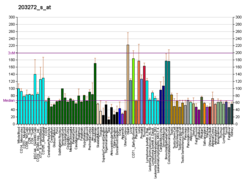Tumor suppressor candidate 2 is a protein that in humans is encoded by the TUSC2 gene.
This gene is a highly conserved lung cancer candidate gene. No other information about this gene is currently available.
References
- ^ GRCh38: Ensembl release 89: ENSG00000114383 – Ensembl, May 2017
- ^ GRCm38: Ensembl release 89: ENSMUSG00000010054 – Ensembl, May 2017
- "Human PubMed Reference:". National Center for Biotechnology Information, U.S. National Library of Medicine.
- "Mouse PubMed Reference:". National Center for Biotechnology Information, U.S. National Library of Medicine.
- Fischer WH, Schubert D (Jan 1997). "Characterization of a novel platelet-derived growth factor-associated protein". J Neurochem. 66 (5): 2213–6. doi:10.1046/j.1471-4159.1996.66052213.x. PMID 8780057. S2CID 28782367.
- Kondo M, Ji L, Kamibayashi C, Tomizawa Y, Randle D, Sekido Y, Yokota J, Kashuba V, Zabarovsky E, Kuzmin I, Lerman M, Roth J, Minna JD (Oct 2001). "Overexpression of candidate tumor suppressor gene FUS1 isolated from the 3p21.3 homozygous deletion region leads to G1 arrest and growth inhibition of lung cancer cells". Oncogene. 20 (43): 6258–62. doi:10.1038/sj.onc.1204832. PMID 11593436. S2CID 24352259.
- ^ "Entrez Gene: TUSC2 tumor suppressor candidate 2".
Further reading
- Prudkin L, Behrens C, Liu DD, et al. (2008). "Loss and reduction of FUS1 protein expression is a frequent phenomenon in the pathogenesis of lung cancer". Clin. Cancer Res. 14 (1): 41–7. doi:10.1158/1078-0432.CCR-07-1252. PMC 2833352. PMID 18172250.
- Lee DY, Deng Z, Wang CH, Yang BB (2008). "MicroRNA-378 promotes cell survival, tumor growth, and angiogenesis by targeting SuFu and Fus-1 expression". Proc. Natl. Acad. Sci. U.S.A. 104 (51): 20350–5. doi:10.1073/pnas.0706901104. PMC 2154434. PMID 18077375.
- Lin J, Sun T, Ji L, et al. (2007). "Oncogenic activation of c-Abl in non-small cell lung cancer cells lacking FUS1 expression: inhibition of c-Abl by the tumor suppressor gene product Fus1". Oncogene. 26 (49): 6989–96. doi:10.1038/sj.onc.1210500. PMC 3457636. PMID 17486070.
- Ewing RM, Chu P, Elisma F, et al. (2007). "Large-scale mapping of human protein-protein interactions by mass spectrometry". Mol. Syst. Biol. 3 (1): 89. doi:10.1038/msb4100134. PMC 1847948. PMID 17353931.
- Gerhard DS, Wagner L, Feingold EA, et al. (2004). "The status, quality, and expansion of the NIH full-length cDNA project: the Mammalian Gene Collection (MGC)". Genome Res. 14 (10B): 2121–7. doi:10.1101/gr.2596504. PMC 528928. PMID 15489334.
- Uno F, Sasaki J, Nishizaki M, et al. (2004). "Myristoylation of the fus1 protein is required for tumor suppression in human lung cancer cells". Cancer Res. 64 (9): 2969–76. doi:10.1158/0008-5472.CAN-03-3702. PMID 15126327.
- Ota T, Suzuki Y, Nishikawa T, et al. (2004). "Complete sequencing and characterization of 21,243 full-length human cDNAs". Nat. Genet. 36 (1): 40–5. doi:10.1038/ng1285. PMID 14702039.
- Strausberg RL, Feingold EA, Grouse LH, et al. (2003). "Generation and initial analysis of more than 15,000 full-length human and mouse cDNA sequences". Proc. Natl. Acad. Sci. U.S.A. 99 (26): 16899–903. Bibcode:2002PNAS...9916899M. doi:10.1073/pnas.242603899. PMC 139241. PMID 12477932.
- Lerman MI, Minna JD (2000). "The 630-kb lung cancer homozygous deletion region on human chromosome 3p21.3: identification and evaluation of the resident candidate tumor suppressor genes. The International Lung Cancer Chromosome 3p21.3 Tumor Suppressor Gene Consortium". Cancer Res. 60 (21): 6116–33. PMID 11085536.
This article on a gene on human chromosome 3 is a stub. You can help Misplaced Pages by expanding it. |





